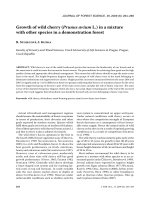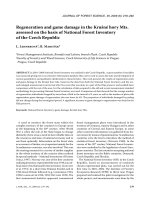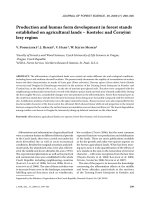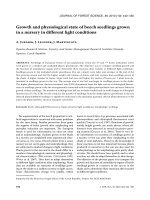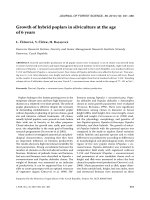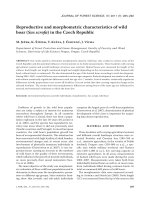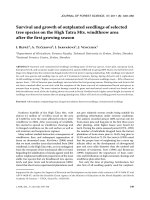Báo cáo lâm nghiệp: " Growth and mineral content of young chestnut trees under controlled conditions of nutrition" ppsx
Bạn đang xem bản rút gọn của tài liệu. Xem và tải ngay bản đầy đủ của tài liệu tại đây (1.4 MB, 13 trang )
Original
article
Growth
and
mineral
content
of
young
chestnut
trees
under
controlled
conditions
of
nutrition
A
Laroche
V
Freyssac
A
Rahmani,
JP
Verger
H
Morvan
Laboratoire
de
biologie
cellulaire
végétale
et
valorisation
des
espèces
ligneuses,
faculté
des sciences,
123,
rue
A-Thomas,
87060
Limoges
cedex,
France
(Received
23
August
1996;
accepted
3
March
1997)
Summary -
The
growth
of
young
forest
trees
under
conditions
of
controlled
nutrition,
limiting
export
and
import
of
nutrients,
is
an
efficient
tool
to
obtain
a
rapid
understanding
of
the
direct
effects
of fertilization.
This
approach
reveals
the
ability
of chestnut
trees
to
(i)
grow
in
a
poor
soil
with
no
additional
supply
of
minerals
for
at
least
2
years
and
(ii)
draw
elements
from
the
mineral
reserve
of
the
soil.
The
growth
of
trees
is
enhanced
by
supplying
nutrients,
especially
NPK.
These
nutrients
directly
modify
the
element
availability
in
the
soil
and
increase
its
pH.
They
also
induce
variations
in
cation
content
within
different
organs,
eg,
significant
increases
in
calcium
and
magnesium
but
not
in
potassium
content.
Moreover,
manganese
seems
to
be
important
for
the
cationic
balance
in
all
organs
as
it
is
accumulated
when
trees
are
unfertilized
but
not
when
quick-lime
is
supplied.
calcium
/
Castanea
sativa
/
fertilization
/
growth
/
mineral
nutrition
Résumé -
Croissance
et
contenu
minéral
de
jeunes
châtaigniers
cultivés
en
conditions
nutritives
contrôlées.
La
culture
contrôlée
de jeunes
arbres
forestiers,
en
limitant
les
entrées
et
sorties
d’éléments
minéraux,
permet
d’évaluer
rapidement
les
effets
directs
de
la
fertilisation.
Ainsi,
le
châtaignier
est
capable
de
pousser
pendant
au
moins
deux
ans
sur
un
substrat
pauvre
et
sans
amendement,
mon-
trant
ainsi
son
aptitude
à
puiser
des
éléments
dans
la
réserve
minérale
du
sol.
Toutefois,
une
fertili-
sation,
notamment
par
NPK,
améliore
sa
croissance.
Ces
apports
modifient
la
disponibilité
des
élé-
ments
dans
le
sol,
y
augmentent
le
pH
et
provoquent
des
variations
des
contenus
cationiques
dans
les
arbres :
augmentation
des
teneurs
en
calcium
et
en
magnésium
mais
pas
en
potassium.
Cependant,
le
manganèse
semble
jouer
un
rôle
important
dans
la
balance
cationique,
puisqu’il
s’accumule
dans
les
arbres
non
fertilisés
et
qu’un
apport
de
chaux
vive
provoque
l’effet
inverse.
calcium
/
Castanea
sativa
/
croissance
/
fertilisation
/
nutrition
minérale
*
Correspondence
and
reprints
Tel:
(33)
05
55
45 73
81;
fax:
(33)
05 55
45
73
86;
e-mail:
INTRODUCTION
Growth
of
trees
is
generally
related
to
min-
eral
nutrition.
Some
deficiencies
greatly
affect
growth,
when
cations
are
lacking
(Shear
and
Faust,
1980;
Spiers
and
Braswell,
1994)
and
particularly
calcium
deficiency
(Davis,
1949; Ramalho et al,
1995).
How-
ever,
the
chestnut
tree
is
known
for
its
abil-
ity
to
grow
on
poor
ground
(Bourgeois,
1992).
In
spite
of
interesting
chemical
and
physical
wood
qualities,
a
wood
failure
known
as
ringshake
frequently
occurs
with
disastrous
marketing
consequences.
Chan-
son
et
al
( 1989)
have
hypothesized
that
this
cohesion
breakdown
is
located
in
the
middle
lamella,
a
cell
wall
area
rich
in
pectins.
These
acid
polysaccharides
are
known
to
be
stabilized
by
calcium
(Demarty
et
al,
1984;
Jarvis,
1984)
and
involved
in
modifi-
cation
of cell
adhesion
(Liners
et
al,
1994).
These
data
suggest
the
potential
role
of
cal-
cium
in
ringshake.
Thus,
this
wood
failure
could
be
related
to
calcium
nutrition
and
its
availability
in
soil.
Soils
in
the
Limousin
(France)
are
acidic
and
relatively
poor
in
available
nutrients
(Verger
et
al,
1985,
1994).
The
aim
of
the
present
work
was
to
determine
whether
fer-
tilizer
treatments
can
modify
the
growth
of
young
chestnut
trees
grown
in
these
soils
and
affect
the
cation
content
of
different
organs
(roots,
bark,
de-barked
stems,
leaves),
especially
divalent
cations.
This
study
was
carried
out
in
a
greenhouse
in
order
to
limit
cation
imports
and
exports
and
to
control
environmental
factors.
MATERIAL
AND
METHODS
Material
One-year-old
chestnut
trees
(Castanea
sativa
Miller)
were
planted
in
March
1994
in
8-L
PVC
pots.
The
culture
substratum
was
composed
of
a
C
horizon
of
Limousin
(middle
west
of
France)
chestnut
forest
soil
(mesotropic
brown
soil)
mixed
with
river
sand
(2:
1 weight
ratio),
which
represented
a
poor
exchangeable
mineral
ele-
ment
substratum.
This
substratum
was
acidic
(pH
H2O
=
5.1;
pH
KCl
=
4.3)
and
was
charac-
terized by
a
very
low
cation
exchange
capacity
of
1.32
cmolc.kg
-1
with
exchangeable
basic
cations:
Ca2+
:
0.30
cmolc.kg
-1
;
Mg2+
:
0.12
cmolc.kg
-1
;
K+:
0.18
cmolc.kg
-1
and
a
total
acid
cations:
H+:
0.15
cmolc.kg
-1
;
Al3+
:
0.40
cmolc.kg
-1
(Freyssac
et al, 1994).
Ten
young
trees
were
kept
in
order
to
quantify
the
element
contents
at
the
time
of
planting.
The
others
were
distributed
between
five
different
fertilizer
treatment
groups
(20
trees
each).
Fertilizer
supplies
The
young
plants
were
grown
under
five
differ-
ent
sets
of
conditions,
A,
B,
C,
D
and
O.
A
consisted
of
a
single
supply
of
quick-lime
(2
cmolc
of
Ca2+
/kg
of
soil,
corresponding
to
1 000
kg.ha
-1
(94.0%
CaO)
for
forest
fertiliza-
tion);
B
consisted
of
a
single
supply
of
Ca
+
Mg
(2
cmolc
of
Ca2+
and
0.5
cmolc
of
Mg2+
per
kg
of
soil,
corresponding
to
2000
kg.ha
-1
(42.0%
CaO
+
10.0%
MgO));
C
consisted
of
B
conditions
+
macroelements
(ammonium
nitrate,
potassium
oxide
and
phos-
phate
at
500
kg.ha
-1
,
for
N
(16.8%
N-NO
3,
16.8%
N-NH
4)
and
also
for
PK
(18.5%
P2O5,
24.0%
K2
O));
D
consisted
of C
conditions
+
trace
elements
(Calmagol
H,
Holimco,
50
kg.ha
-1
with
a
com-
position
of:
Ca:
32.5%,
Mg:
3.3%,
Fe:
0.7%,
Mn:
0.007%,
Cu,
Co
and
Ni
traces);
O
was
a
control
with
no
additional
elements.
The
letters
A,
B,
C,
D
and
O
will
be
taken
to
mean
the
trees
and/or
conditions
under
which
they
were
grown.
The
fertilizers
were
mixed
into
the
substra-
tum,
pot
by
pot,
before
planting.
Experiments
were
performed
in
semi-controlled
conditions
in
the
greenhouse
with
temperature
measurement.
The
temperature
varied
from
a
minimum
of
2
°C
during
the
winter
to
a
maximum
of
45 °C
in
the
summer.
Being
protected
against
rain
fall,
the
trees
were
watered
with
deionized
water
exclu-
sively
between
one
and
eight
times
per
month
depending
on
temperature.
Moreover,
leaves
from
each
batch
were
collected
when
they
fell,
then
reduced
to
a
powder
for
further
analysis.
An
aliquot
was
used
for
mineral
composition
(data
not
shown)
and
the
rest
was
added,
in
late
January
1995,
to
the
surface
of
the
corresponding
substratum
of
the
trees
that
were
not
destruc-
tively
harvested.
Methods
Growth
parameters,
such
as
height,
base
diame-
ter
(at
soil
surface),
number
of
branches
and
sum
of
annual shoot
length,
were
measured
for
each
tree
in
March
1994
(planting),
September
1994
and
June
1995.
The
fourth
leaf from
each
apex
was
gathered
15
days
before
harvesting
in
September
1994
and
June
1995,
and
also
the
foliage
of
trees
was
harvested
in
order
to
estimate
the leaf
area
by
cutting
up
and
weighing
paper
copies.
Trees
were
grouped
into
three
categories
for
each
treatment:
small,
medium
and
large,
accord-
ing
to
the
sum
of
annual
shoot
length.
Three
plants,
the
medium-sized
trees
of
each
category,
were
harvested
to
provide
material
for
mineral
content
at
each
harvest
time
except
at
initial
plant-
ing
when
six
trees
were
randomly
sampled.
Roots
(washed
with
deionized
water),
bark,
leaves
and
de-barked
stems
were
manually
separated
and
oven
dried
at
80 °C
for
2
h
then
at
60 °C
for
48
h
(to
a
constant
mass).
Plant
materials
were
then
weighed
and
powdered
using
a
ball-bearing
shaker.
Except
for
current
year
de-barked
stems
of
which
there
was
insufficient
quantity,
0.2
g
of
each
sample
was
weighed
out
and
digested
for
10
min
at
600 °C
in
14
mL
of
a
2:6:6
(v/v/v)
mixture
of
H2
SO
4,
HNO
3
and
H2O2
according
to
Hoenig
and
Vanderstappen
(1978).
Concen-
trations
of
Ca,
Mg
and
Mn
were
determined
by
atomic
absorption
and
K
contents
by
atomic
emission
spectrophotometry
(Atomspek
H
1170-
Hilger
&
Watts).
The
substrata
of
the
three
harvested
plants
for
each treatment
were
mixed
together
at
harvest
time
(September
1994,
January
1995
and
June
1995).
As
powdered
leaves
were
applied
in
Jan-
uary
1995,
the
upper
5
cm,
where
there
were
no
roots,
were
not
taken
into
account.
The
pH
of
the
air-dried
and
sieved
(2
mm)
samples
of
sub-
stratum
was
measured
in
deionized
water
(w/w,
2:5)
after
standing
overnight.
The
pH
was
also
determined
for
samples
collected
in
March
1994
before
planting.
Statistical
analysis
Growth
parameter
analyses
were
expressed
as
the
mean
of
20
individual
values
at
the
begin-
ning
of
the
study,
to
10
individual
values
at
the
end,
and
the
Mann
and
Whitney
U
test
(1947)
was
applied
with
a
threshold
of
5%.
Mineral
analyses
were
performed
individu-
ally,
on
three
different
trees
for
each
treatment
at
the
sampling
date.
Results
were
expressed
as
the
mean
of
the
three
values
and
the
Mann
and
Whit-
ney
U
test
(1947)
was
again
applied,
with
a
threshold
of
5%.
RESULTS
Growth
parameters
At
the
time
of
planting
(March
1994),
the
heights
of
the
1-year-old
chestnut
trees
ranged
from
22
to
52
cm.
The
mean
heights
(table
I)
and
base
diameters
(table
II)
of
trees
were
similar
for
all
treatments
except
A,
where
the
trees
were
10%
smaller
than
those
in
the
other
treatments,
by
chance.
Six
months
later
(September
1994),
the
heights
of
the
trees
varied
individually
from
28
to
66
cm
but
the
treatment
mean
values
were
not
significantly
different
(table
I).
The
same
pattern
was
observed
in
the
diam-
eter
measurements
(table
II).
In
September
1994,
significant
increases
in
the
sums
of
the
shoot
length
were
observed
in
C
and
D
compared
to
O
and
A
(table
III).
The
B
trees
produced
an
intermediate
effect.
However,
no
significant
effect
was
seen
in
terms
of
the
number
of
ramifications.
During
the
second
growing
season
(June
1995),
the
C
and
D
trees
were
significantly
greater
in
terms
of
all
growth
parameters
measured,
especially
for
the
sums
of shoot
length,
which
were
four
times
greater
than
in
O
(tables
I,
II
and
III).
As
far
as
all
mea-
surements
were
concerned,
no
significant
effects
were
observed
for
A.
A
slight
effect
was
observed
for
treatment
B,
in
comparison
with
O,
but
only
the
diameters
were
signif-
icantly
higher
(table
II).
From
1994,
the
area
of
the
fourth
leaf of
the
D
trees
was
significantly
higher
than
that
of
O
trees
(table
IV).
This
difference
was
even
greater
in
June
1995,
depending
on
the
fertilizer
supplies.
Thus,
C
and
D
induced
a
significant
increase
in
the
area
of
the
4th
leaf
compared
to
the
other
treat-
ments.
Moreover,
the
total
foliage
area
showed
the
same
trend
(table
V).
In
1995,
this
value
was
four
times
greater
in
C
and
D,
and
intermediate
in
B
trees
compared
to
O
and
A
trees.
pH
substratum
evolution
Before
both
fertilization
treatments
and
planting,
the
pH
of
the
substratum
was
5.1
but
increased
to
pH
6.4
where
quick-lime
(calcium
supply)
was
added.
Furthermore,
the
pH
was
greater
(6.8-6.9)
where
the
sub-
strata
were
supplemented
with
the
other
fer-
tilizers
(table
VI).
The
substratum
pH
remained
acidic
and
stable
under
O
and
slight
acidification
was
observed
under
A.
In
contrast,
pH
values
increased
slightly
but
irregularly
under
other
conditions,
during
the
experimental
period.
Mineral
contents
At
each
sampling
date,
the
root
Ca
levels
(fig
1a)
were
at
least
twice
as
high
where
fertilizer
was
supplied
(A,
B,
C
and
D)
than
without
(O).
Under
O,
a
very
low
Ca
con-
centration
was
observed
in
September
1994,
which
increased
significantly
as
early
as
January
1995
and
was
found
to
be
identi-
cal
in
September
1995
(four
times
less
in
1994
than
in
January
and
September
1995).
As
early
as
September
1994,
the
same
trend,
ie,
an
increase
in
Ca
between
September
1994
and
January
1995
and
a
slight
variation
until
September
1995,
was
observed
but
less
markedly
for the
same
set
of
conditions.
The
root
Mg
levels
in
September
1994
(fig
1b)
were
greater
by
up
to
75%
for
trees
supplied
with
Mg
(B,
C
and
D),
compared
to
those
that
did
not
receive
Mg
(O, A).
In
September
1995,
Mg
levels
were
25%
lower
than
in
1994
in
all
cases.
The
K
levels
(fig
1c)
showed
a
slight
treatment
effect
where
K
was
supplied
(C
and
D)
in
Septem-
ber
1994.
And
a
decreasing
trend
of
K
con-
centrations
occurred
under
O
and
A
between
January
and
September
1995
and
under
C
and
D
between
September
1994
and
September
1995.
The
Mn
levels
(fig
1d)
were
twice
as
high
without
fertilizer
(O)
than
under
other
conditions
and
increased
in
the
second
year,
especially
in
O
but
not
for
D.
The
Ca
levels
in
de-barked
stem
(fig
2a)
showed
a
significant
increase
(double)
from
September
1994
to
September
1995
for
A,
C,
D
and
O
but
not
for
B.
The
increase
in
Ca
concentration
when
calcium
was
applied
as
well
as
CaMg)
also
revealed
a
fertilizer
effect.
The
Mg
levels
followed
the
same
pattern:
they
increased
when
mag-
nesium
was
applied
(fig
2b),
and
a
tendancy
to
increase
over
time
was
observed
for
all
treatments,
except
B.
The
concentration
of
K
decreased
with
the
addition
of
fertilizer
(fig
2c).
The
K
levels
increased
in
1995
in
O
and
A
and
remained
constant
for the oth-
ers.
The
highest
Mn
levels
(fig
2d)
were
obtained
in
O
and
gradually
decreased
from
A
to
C
and
D.
In
addition,
the
Mn
concen-
trations
of
O
trees
were
higher
in
September
1995
than
in
1994.
The
Ca
levels
in
bark
(fig
3a)
were
dou-
ble
those
of
the
control
in
treatments
where
Ca
was
supplied.
They
revealed
an
increase
from
September
1994
to
September
1995
(except
in
the
control),
which
was
particu-
larly
marked
in
A,
C
and
D.
In
figure
3b,
an
increase
(50%)
in
the
Mg
level
was
observed
in
Mg
supplied
trees
as
well
as
a
significant
Mg
decrease
from
September
1994
to
September
1995.
The
K
levels
showed
no
significant
treatment
effects.
There
was
a
trend
in
K
concentration,
an
increase
in
O
and
A
but
a
decrease
in
C
and
D,
over
time
(fig
3c).
The
Mn
concentra-
tions
(fig
3d)
were
twice
as
high
in
O
and
tended
to
gradually
decrease
from
A
to
C
and D.
The
results
presented
in
figure
4a
show
a
strong
fertilizer
effect
on
Ca
levels
in
leaves,
which
tripled
in
treatments
where
calcium
was
supplied.
These
levels
remained
similar,
between
harvest
dates.
In
September
1994,
an
increase
in
Mg
concentrations
(fig
4b)
was
observed
for
the
three
treatments
that
contained
a
magnesium
supply,
whereas
these
levels
decreased
steeply
and
were
sta-
tistically
significant
(30-40%)
in
Septem-
ber
1995
(B,
C
and
D).
The
pattern
of
K
revealed
highest
levels
in
O
and
A.
This
sit-
uation
was
more
marked
during
the
second
year
(fig
4c).
The
Mn
levels
(fig
4d)
were
higher
in
O
and
A
than
in
the
three
other
treatments
in
September
1994.
In
September
1995,
the
Mn
level
was
also
higher
in
O
trees
than
in
the
others.
DISCUSSION
In
forest
nutrition
studies
(Hytonen,
1995),
experiments
are
generally
carried
out
over
several
years
in
order
to
obtain
significant
treatment
effects
and
to
limit
the
variabil-
ity
due
to
both
climatic
and
biotic
factors.
It
is
evident
that
to
work
under
natural
condi-
tions,
many
parameters
and
interactions
must
be
managed
and
it
is
thus
necessary
to
simplify
the
experiments.
In
this
study,
the
experiments
were
conducted
under
closed
conditions
in
a
greenhouse.
The
plants
were
protected
from
the
weather
so
that
a
number
of
physical
and
biological
factors
that
can
represent
export
(loss
by
percolation,
flora,
fauna,
etc)
or
import
(rain-
fall
element,
decomposition
of
pre-existing
litter,
etc)
parameters
were
controlled
in
this
study.
Apart
from
the
fact
that
the
mineral
composition
of
the
substratum
was
already
known
(Freyssac
et
al,
1994),
supplies
were
tightly
controlled,
deionized
water
was
used
for
watering
and
finally
the
leaf
mineral
composition
was
quantified
at
leaf
fall
in
order
to
take
it
into
account
(data
not
shown).
This
experimental
approach
results
in
a
better
understanding
of
fertilization
effects
by
reducing
annual
variations
in
atmospheric
and
biotic
factors
(Ranger,
1981).
Following
Bourgeois
(1992),
we
con-
firmed
that
chestnut
trees
are
able
to
grow
for
at
least
2
years
on
an
exchangeable
ele-
ment-poor
substratum
such
as
the
C
Horizon
of mesotropic
brown
soil
(Verger
et
al,
1985,
1994)
watered
only
with
totally
deionized
water.
This
growth
capacity
on
a
substra-
tum
poor
in
exchangeable
elements
could
reveal
an
ability
to
draw
mineral
elements
from
the
soil
reserve,
as
hypothesized
by
Brethes
and
Nys
(1975)
with
resinous
trees.
parameter
analysis
shows
some
differences
depending
on
both
culture
dura-
tion
and
fertilizer
effects.
A
slight
growth
increase
was
observed
from
September
1994,
probably
owing
to
NPK
supply
(C
and
D).
The
leaf
areas
followed
a
similar
pattern.
During
the
second
year,
these
obser-
vations
were
confirmed.
All
growth
param-
eters
increased
significantly
following
an
NPK
(including
calcium
and
magnesium)
supply,
but
to
a
lesser
extent
with
CaMg.
Some
differences
concerning
leaf
morphol-
ogy
and
colour
were
also
observed
in
1995.
Leaves
were
either
rounded,
large
and
deep-
green
or
small,
elongated
and
yellow-green
with
or
without
an
NPK
supply,
respectively
(data
not
shown).
Taken
together
these
results
give
rise
to
two
hypotheses:
i)
Ca
and/or
Mg
are
not
the
sole
deficient
ele-
ment(s)
in
the
substratum
used;
ii)
the
fer-
tilizer
supplies
modify
the
cation
balance
in
soil.
The
nutrient
ratios
in soil
affect
absorption
and
translocation,
and
conse-
quently
growth
(Shear
and
Faust,
1980;
Jad-
czuk
and Lenz,
1994).
The
addition
of Ca
and
CaMg
increases
the
growth,
which
shows
the
deficiency
of
both
elements
in
the
substratum.
A
greater
effect
on
growth
and
foliage
development
is
observed
when
NPK
fertilizer
is
added,
indicating
that
at
least
one
of
them
(N,
P
or
K)
is
initially
insufficient.
In
addition,
nutri-
ent
supplies
can
modify
the
cation
balance
either
by
a
direct
effect
or
via
a
pH
variation
and
consequently
modify
the
cation
absorp-
tion
(Maas
et
al,
1969;
Iyengar
and
Reddy,
1993;
Jadczuk and
Lenz,
1994;
Ramalho
et
al,
1995).
Moreover,
some
studies
show
cor-
relations
between
soil
acidification
and
cation
availability
(Ross
et
al,
1985;
Whigham
and
Richarson,
1988;
Neilsen
et
al,
1994;
Ljungström
and
Nihlgard,
1995).
In
our
study,
all
the
fertilizer
supplies
induce
an
increase
in
soil
pH.
Used
alone,
calcium
enhances
the
soil
pH
but
less
than
when
it
is
added
with
other
elements
(Mg
and
NPKMg).
Chestnut
trees,
which
are
known
for
their
ability
to
grow
in
acid
soils,
have
shown
a
marked
tendancy
to
grow
under
slightly
basic
pH
conditions.
These
results
are
not
contradictary,
indeed
the
basic
pH
is
not
related
to
limestone,
which
inhibits
the
growth
of chestnut
trees
(Bourgeois,
1992).
The
differences
in
both
growth
and
foliage
development
that
were
observed
between
the
first
and
second
year
could
be
attributed
to
nutrient
storage
within
the
plant,
resulting
from
previous
non-deficiency
cul-
ture
conditions.
This
is
probably
a
sufficient
reason
to
explain
the
marked
growth
responses
during
the
second
year.
In
addition
to
the
fertilizer
effects
on
chestnut
tree
morphology,
some
fertilizer
effects
have been
observed
concerning
the
mineral
contents.
Results
show
different
mineral levels
according
to
the
components
tested.
Thus,
all
minerals
studied
have
the
lowest
concentrations
in
wood
(de-barked
stem)
and
root
samples,
whereas
they
are
higher
in
bark
and
then
in
leaves
for
Ca
and
inversely
for
Mg,
Mn
and
K.
These
results
are
in
agreement
with
those
reported
in
other
species
such
as
Scots
pine
(Ranger,
1981)
and
larch
(Myre
and
Camire,
1994).
In
our
experiments,
the
same
trend
is
observed
in
mineral
concentrations
in
all
components,
whatever
the
fertilizer
effect.
Moreover,
we
note
that
the
leaf/any
other
component
ratio
(but
only
to
a
lesser
extent
with
bark)
of
Mn
concentrations
are
the
highest
(ten
for
Mn
and
three
for
Ca,
Mg
and
K).
Furthermore,
the
foliar
area
of
the
fourth
leaf
reveals
the
same
pattern
as
the
total
foliage
area
and
also
the
mineral
content
(data
not
shown).
Thus,
in
agreement
with
previous
works
(Ljungström
and
Nihlgard,
1995;
Ramalho
et
al,
1995),
leaf
sampling
can
be used
to
estimate
the
cation
status
in
trees
and
is
con-
sequently
a
rapid
method
of
revealing
ion
deficiencies.
According
to
Ljungström
and
Nihlgard
(1995),
Ca
and
Mg
concentrations
increase
markedly
during
the
first
year,
with
calcium
and
magnesium
supplies,
respec-
tively.
By
contrast,
the
potassium
supply
has
no
effect
on
any
of
the
mineral
contents
studied,
including
itself.
This
element
may
be
present
in
sufficient
proportions
in
the
plant,
taking
into
consideration
the
K
level
in
leaves
(0.87%)
under
optimal
nutritional
conditions
(Colin-Belgrand
et
al,
1993).
In
addition,
the
concentration
of each
ele-
ment
varied
differently
within
each
com-
ponent
over
time.
For
instance,
the
Ca
level
increased
from
September
1994
to
Septem-
ber
1995,
even
under
control
conditions
and
more
markedly
with
all
other
fertilizer
sup-
plies.
This
accumulation
of Ca,
with
no addi-
tional
supply,
is
observed
in
all
components.
Thus,
this
cannot
be
explained
by
a
redis-
tribution
of
stored
calcium
from
one
com-
ponent
to
others.
According
to
our
experi-
mental
conditions,
the
only
calcium
source
for
the
young
trees
cultured
with
no
supply
was
the
substratum,
poor
in
exchangeable
mineral
elements
(Freyssac
et
al,
1994).
Consequently,
the
enhancement
of calcium
concentrations
observed
in
all
plant
com-
ponents
could
reveal the
ability
of
chestnut
to
draw
up
mineral
elements
from
the
soil
reserve,
as
observed
in
resinous
trees
(Brethes
and
Nys,
1975),
via
a
disorganiza-
tion
of
clay
colloids,
which
increases
ion
availability.
The
evolution
of Mg
concen-
trations
was
the
reverse:
a
decrease
was
observed
during
the
experimentation
time
under
all
conditions,
especially
in
leaves
and
bark,
because
it
could
have
been
absorbed
mainly
during
the
first
months
of
culture
and
to
a
lesser
extent
later.
The
dif-
ference
between
the
accumulation
levels
of
these
cations
can
be
explained
by
the
lower
mobility
of Ca
(Ferguson
and
Bollard,
1976;
Marschner,
1986;
Hytönen,
1995)
or
dif-
ferences
in
absorption
rate
between
calcium
and
magnesium,
via
interactions
between
cations
(Maas
et
al,
1969;
Jadczuk
and
Lenz,
1994).
In
order
to
fully
understand
these
phenomena,
it
will
be
interesting
to
take
the
substratum
cation
content
into
account.
Finally,
we
would
like
to
point
out
the
case
of
Mn
whose
levels
are
higher
under
control
conditions
than
all
others.
Other
works
show
a
decrease
in
leaf
manganese
concentration
in
relation
to
an
increase
in
soil
pH
and
a
negative
correlation
between
Mn
leaf
concentration
and
growth
(Spiers
and
Braswell,
1994).
Neilsen
et
al
(1994)
reported
a
maximum
Mn
content
in
leaves
at
pH
4.8
and
a
relationship
between
soil
acid-
ification
and
increasing
solubility
of
toxic
elements
such
as
manganese
and
aluminium.
In
addition,
variations
in
soil
pH
modify
the
cation
availability.
For
example,
a
decrease
in
pH
from
6.1
to
3.5
induces
a
16-fold
increase
in
extractable
Mn2+
(Ross
et
al,
1985).
Thus,
these
manganese
and
alu-
minium
availabilities
can
cause
phytotoxi-
city
and
imbalanced
nutrition,
aggravating
the
cation
deficiencies.
Since
a
calcium
sup-
ply
induces
a
strong
decrease
in
Mn
level,
this
study,
in
agreement
with
Ljungström
and
Nihlgard
(1995),
suggests
that
the
man-
ganese
content
of
a plant
component
can
be
used
as
a
marker
of
calcium
and
perhaps
other
mineral
deficiencies.
In
conclusion,
our
study
shows
the
impact
of
some
fertilizations
on
both
growth
and
some
mineral
contents
of
young
chestnut
trees.
It
would
be
interesting
to
study
their
effects
over
several
years.
Our
results,
con-
cerning
the
low
cation
concentrations
in
de-
barked
stem,
calcium
in
particular,
without
fertilization,
give
support
to
the
hypothesis
concerning
the
potential
role
of calcium
in
ringshake.
It
will
be
necessary
to
study
mechanical
resistance
of
wood
in
correla-
tion
with
calcium
content
in
order
to
find
out
if calcium
deficiency
in
situ
influences
the
mechanical
qualities
of
wood.
In the
near
future,
we
aim
to
specify
the
localiza-
tion
of
cations
in
situ,
using
SIMS
(sec-
ondary
ion
mass
spectrometry),
which
appeared
to
be
a
useful
means
of
studying
the
calcium
distribution
in
plant
tissues
(Jauneau
et
al,
1992;
Roy
et
al,
1995).
It
will
also
be
important
to
link
calcium
local-
ization
to
the
content
and
metabolism
of
pectins.
Acknowledgment:
We
wish
to
thank
Mr
Alas-
tair
Balloch
for
linguistic
advice.
REFERENCES
Bourgeois
C
(1992)
Le
châtaignier:
un
arbre,
un
bois.
Institut
pour
le
développement
Forestier,
Paris
Brethes
A,
Nys
C
(1975)
Effets
des
résineux
sur
la
fer-
tilité
des
sols. Difficulté
des
reeherches et
premiers
résultats.
Sci
Sol
1, 3-18
Chanson
B,
Leban
JM,
Thibaut
B
(1989)
La
roulure
du
châtaignier
(Castanea sativa
Mill.).
Forêt
Médi-
terranéenne
XI,
15-34
Colin-Belgrand
M,
Ranger
J,
Bouchon
J,
d’Argouges
S
(1993)
Transferts
internes
d’éléments
nutritifs
dans
le
bois
de
châtaignier
(Castanea
sativa
Mill.):
approche
dynamique
sur
une
chronoséquence
de
peuplements:
I.
Distribution
des
éléménts
miné-
raux.
Acta
Oecologica
14, 653-680
Davis
DE
(1949)
Some
effects
of
calcium
deficiency
on
the
anatomy
of
Pinus
tadea.
Am
J Bnt
36, 276-282
Demarty
M,
Morvan
C,
Thellier
M
(1984)
Calcium
and
the
cell
wall.
Plant
Cell
Environ
7,
441-448.
Ferguson
IB,
Bollard
EG
(1976)
The
movement
of cal-
cium
in
woody
stems. Ann Bot 40,
1057-1065
Freyssac
V,
Rahmani
A,
Carlue
M,
Verger
JP,
Morvan
H
(1994)
Contribution
à l’étude
de
la
roulure
du
châtaignier.
Etude
expérimentale
des
conséquences
d’amendements
calciques.
I-
Relation
entre
la
com-
position
minérale
du
milieu
et
celle
de jeunes
plants.
Ann
Sci
Limousin
10, 25-34
Hoenig
M,
Vanderstappen
R
(1978)
Dosage
dc
Cd,
Cu,
Pb,
Zn
et
Mn
dans
les
végétaux
par
spectro-
métrie
d’absorption
atomique
en
flamme.
Effets
de la
minéralisation.
Analusis
6, 312-316
Hytonen
J
(1995)
Effect
of
fertilizer
treatment
on
the
biomass
production
and
nutrient
uptake
of
short
rotation
willow
on
cut
away
Peatlands. Silva
Fen-
nica 29, 21-40
lyengar
ER,
Rcddy
MP
(1993)
Crop
response
to
salt
stress:
seawater
application
and
prospects.
In:
Hand-
book
of
Plant
and
Crop
Stress
(M
Pcssarakli,
cd),
Marcel
Dekker
Inc,
New
York,
183-201
Jadczuk
E,
Lcnz
F
(1994)
Effect
of
nutrient
supply
and
fruit
load
on
K
concentration
in
plant
organs
of
apple.
Gartenbauwissenschaft 59,
149-153
Jarvis
M
C
(1984)
Structure
and
properties
of
pectin
gels
in
plant cell
walls.
Plant
Cell Environ
7,
153-
164
Jauneau
A,
Ripoll
C,
Rihouey
C,
Demarty
M,
Thoiron
A,
Martini
F,
Thellier
M
(1992)
Localisation
du
Ca
et
Mg
par
microscopie
ionique
analytique
dans
des
plantules
de
lin:
utilisation
d’une
méthode
dc
precipitation
au
pyroantimoniate
de
potassium.
C
R
Acad
Sci
315
(III),
179-188
Liners
F,
Gaspar
T,
Van
Cutsem
P,
(1994)
Acetyl-
and
methyl-esterification
of pectins
of friable
and
com-
pact
sugar
beet
calli:
consequences
for
inter
cellu-
lar
adhesion. Planta 192, 545-556
Ljungström
M,
Nihlgard
B
(1995)
Effects
of
lime
and
phosphate
additions
on
nutrient
status
and
growth
of
beech
(Fagus
svlvatic
L)
seedlings.
For
Ecnl
Manag 74, 133-148
Maas
EV,
Moore
DP,
Mason
BJ
(1969)
Influence
of
calcium
and
magnesium
on
manganese
absorption.
Plant
Physiol 44,
796-800
Mann
HB,
Whitney
DR
(1947)
On
a
test
of
whether
one
of
two
random
variables
is
stochasticaly
larger
than
the
other.
Ann
Math
Statis
18, 52-54
Marschner
H
( 1986)
Mineral
Nutrition
of Higher
Plants.
Academic
Press,
London
Myre
R
Camire
C
(1994)
Distribution
de
P,
K,
Ca,
Mg,
Mn
et
Zn
dans
la
tige
des
mélèzes
curopéen
et
laricin.
Ann
Sci
For
51,
121-134
Neilsen
GH,
Parchomchuk
P,
Hogue
EJ,
Wolk
WD,
Lau
OL
(1994)
Response
of
apple
trees
to
fertiga-
tion-induced
soil
acidification.
Can
J Plant
Sci
74,
347-351
Ramalho
JC,
Rebelo
MC,
Santos
ME,
Antunes
ML,
Nunes
MA
(1995)
Effects
of calcium
deficiency
on
Coffea
arbica.
Nutrient
changes
and
correlation
of calcium
levels
with
some
photosynthetic
param-
eters.
Plant
Soil
172,
87-96
Ranger
J
(1981)
Etude
de
la
minéralomasse
et
du
cycle
biologique
dans
deux
peuplements
de
Pin
laricio
de
Corse
dont
l’un
a
été
fertilisé
à la
plantation.
Ann Sci For 38, 127-158
Ross
GJ,
Hoyt
PB,
Neilsen
GH
(1985)
Soil
chemical
and
mineralogical
changes
due
to
acidification
in
okanagan
apple
orchards.
Can
J Soil
Sci
65,
347-
355
Roy
S,
Gillen
G,
Conway
WS,
Watada
AE,
Wergin
WP
(1995)
Use
of secondary
ion
mass
spectrome-
try
to
image
44
calcium
uptake
in
the
cell
walls
of
apple
fruits.
Protoplasma
189,
163-172
Shear CB,
Faust
M
(1980)
Nutrition
ranges
in
decidu-
ous
tree
fruits
and
nuts.
Hortic
Rev
2,
146-163
Spiers
JM,
Braswell
JH
(1994)
Response
of
’Sterling’
muscadine
grape
to
calcium,
magnesium
and
nitro-
gene
fertilization.
J Plant
Nutr
17,
1739-1750
Verger
JP,
Vilks
A,
Javellaud
J.
Botineau
M
(1985)
Lc
taillis
dc
châtaignier
de
la
forêt
communale
de
Cussac
(87),
rapport
sol-vegetation.
Colloques
phy-
tosociologiques
XIV:
Phytosociologie
et
Foresterie,
Nancy
Verger
JP.
Domain
Ph,
Fournier
JM,
Maisonier
C,
Djomo
JE
(1994)
Importance
du
calcium
dans
le
développement in
situ
du
taillis
de
châtaignier
en
Limousin.
Am
Sci
Limousin
1,
25-34
Whigham
DF,
Richardson
CJ
(1988)
Soil
and
plant
chemistry
of
an
Atlantic
white
cedar
wetland
on
the
Inner
Coastal
Plain
of
Maryland.
Can
J Bot 66,
568-576
